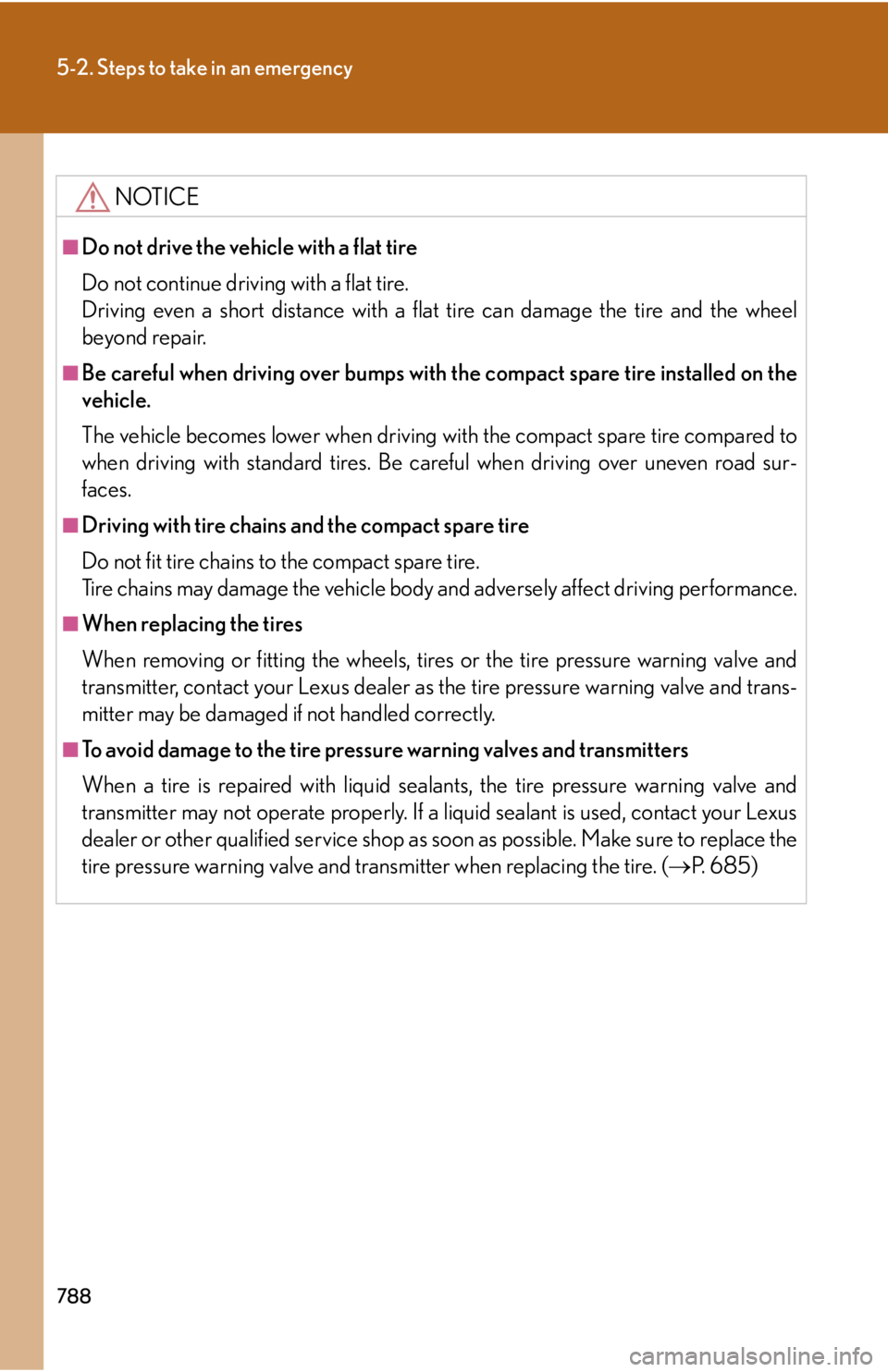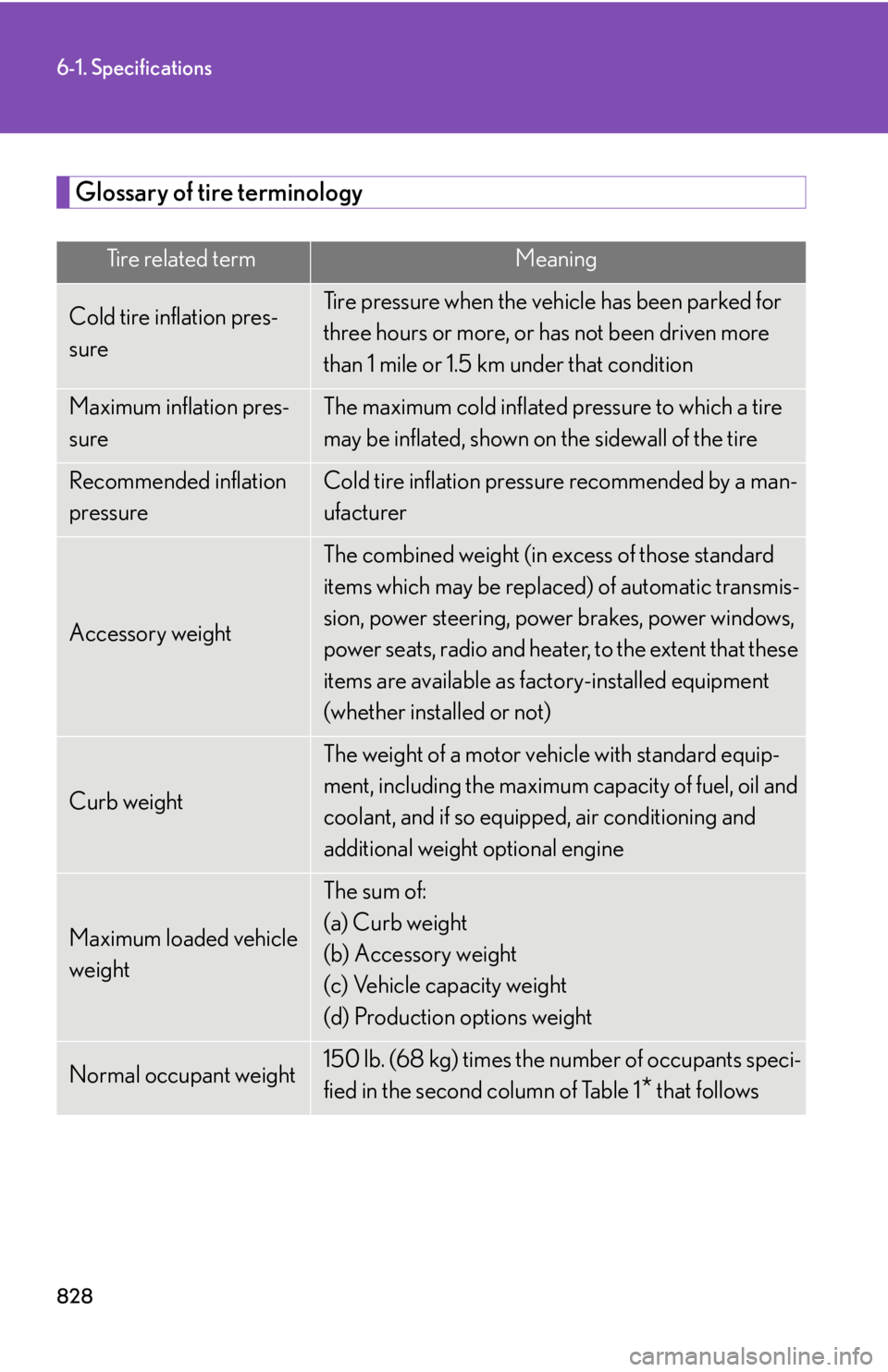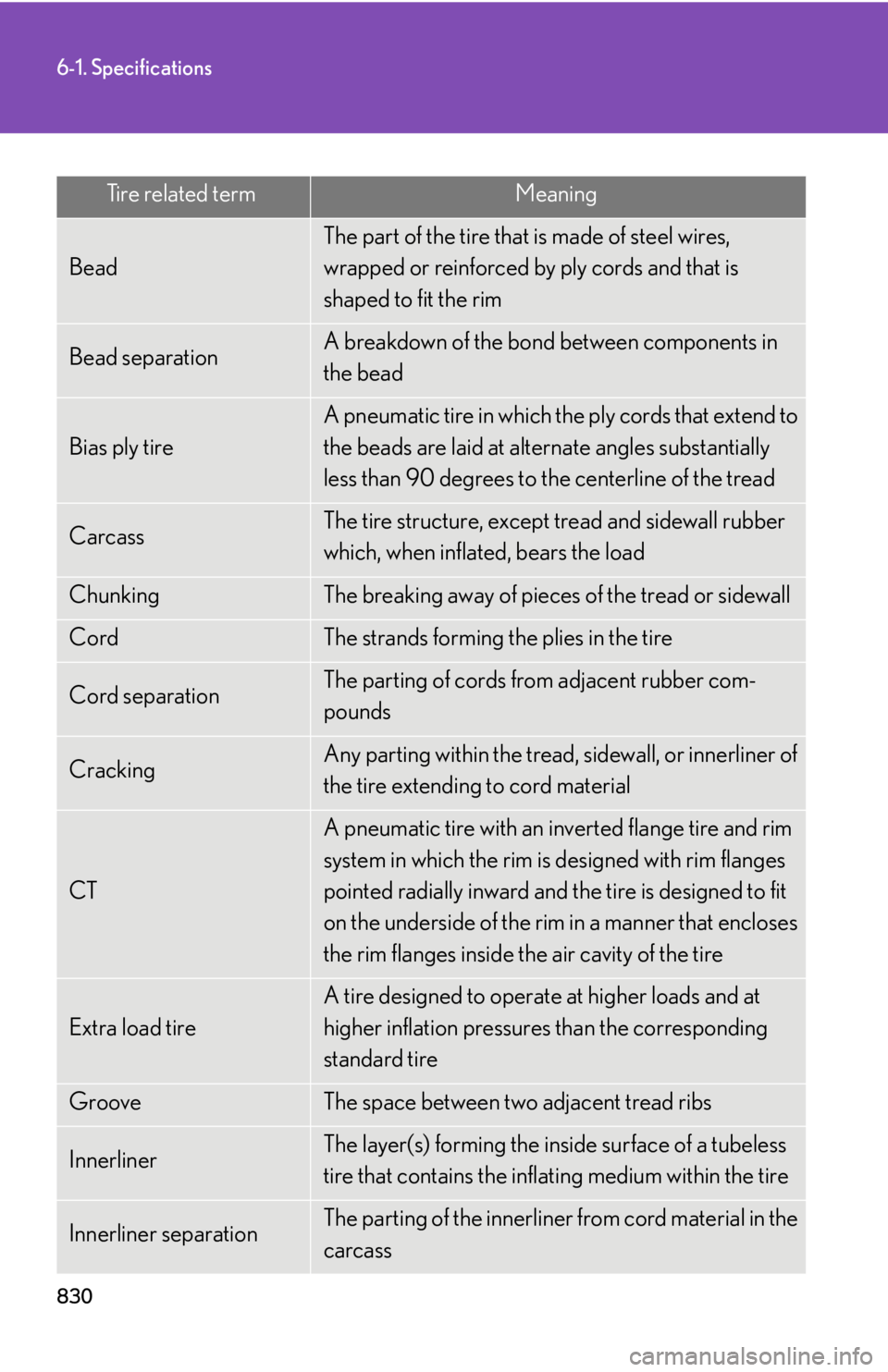Page 788 of 886

7885-2. Steps to take in an emergency
NOTICE■
Do not drive the vehicle with a flat tire
Do not continue driving with a flat tire.
Driving even a short distance with a flat tire can damage the tire and the wheel
beyond repair.■
Be careful when driving over bumps with the compact spare tire installed on the
vehicle.
The vehicle becomes lower when driving with the compact spare tire compared to
when driving with standard tires. Be careful when driving over uneven road sur-
faces.■
Driving with tire chains and the compact spare tire
Do not fit tire chains to the compact spare tire.
Tire chains may damage the vehicle body and adversely affect driving performance.■
When replacing the tires
When removing or fitting the wheels, tire s or the tire pressure warning valve and
transmitter, contact your Lexus dealer as the tire pressure warning valve and trans-
mitter may be damaged if not handled correctly.■
To avoid damage to the tire pressure warning valves and transmitters
When a tire is repaired with liquid seal ants, the tire pressure warning valve and
transmitter may not operate properly. If a liquid sealant is used, contact your Lexus
dealer or other qualified service shop as so on as possible. Make sure to replace the
tire pressure warning valve and transmitter when replacing the tire. ( P. 685)
Page 817 of 886
8156-1. Specifications
6
Vehicle specifications Tires and wheels
Type A
Type BTi r e s i z e P235/60R18 102V, T165/90D18 107M (spare)
Tire inflation pressure
(recommended cold tire
inflation pressure) Driving under normal conditions
Front:
32 psi (220 kPa, 2.2 kgf/cm 2
or bar)
Rear:
32 psi (220 kPa, 2.2 kgf/cm 2
or bar)
Spare:
60 psi (420 kPa, 4.2 kgf/cm 2
or bar)
Wheel size 18 7 1 /2J, 18 4T (spare)
Wheel nut torque 76 ft•lbf (103 N•m, 10.5 kgf•m)
Ti r e s i z e P235/60R18 102V
Tire inflation pressure
(recommended cold tire
inflation pressure) Driving under normal conditions
Front:
32 psi (220 kPa, 2.2 kgf/cm 2
or bar)
Rear:
32 psi (220 kPa, 2.2 kgf/cm 2
or bar)
Spare:
32 psi (220 kPa, 2.2 kgf/cm 2
or bar)
Wheel size 18 7 1 /2J
Wheel nut torque 76 ft•lbf (103 N•m, 10.5 kgf•m)
Page 818 of 886

8166-1. Specifications
Ty p e C
Ty p e DTi r e s i z e P235/55R19 101V, T165/90D18 107M (spare)
Tire inflation pressure
(recommended cold tire
inflation pressure) Driving under normal conditions
Front: 32 psi (220 kPa, 2.2 kgf/cm 2
or bar)*
Rear: 32 psi (220 kPa, 2.2 kgf/cm 2
or bar)*
Spare: 60 psi (420 kPa, 4.2 kgf/cm 2
or bar)*: When driving at high speeds above 100 mph (160
km/h), in countries where such speeds are permitted
by law, add 1 psi (10 kPa, 0.1 kgf/cm 2
or bar) to the
front tires, 3 psi (20 kPa, 0.2 kgf/cm 2
or bar) to the
rear tires. Never exceed the maximum cold tire infla-
tion pressure indicated on the tire sidewall.
Wheel size 19 7 1 /2J, 18 4T (spare)
Wheel nut torque 76 ft•lbf (103 N•m, 10.5 kgf•m)
Ti r e s i z e P235/55R19 101V
Tire inflation pressure
(recommended cold tire
inflation pressure) Driving under normal conditions
Front: 32 psi (220 kPa, 2.2 kgf/cm 2
or bar)
Rear: 32 psi (220 kPa, 2.2 kgf/cm 2
or bar)
Spare: 32 psi (220 kPa, 2.2 kgf/cm 2
or bar)
When driving at high speeds above 100 mph (160 km/h),
in countries where such speeds are permitted by law, add
1 psi (10 kPa, 0.1 kgf/cm 2
or bar) to the front tires, 3 psi
(20 kPa, 0.2 kgf/cm 2
or bar) to the rear tires. Never
exceed the maximum cold tire inflation pressure indi-
cated on the tire sidewall.
Wheel size 19 7 1 /2J
Wheel nut torque 76 ft•lbf (103 N•m, 10.5 kgf•m)
Page 824 of 886

8226-1. Specifications
Tire ply composition and materials Plies are layers of rubber-coated parallel cords. Cords are the strands
which form the plies in a tire.
Radial tires or bias-ply tires A radial tire has “RADIAL” on the sidewall. A tire not marked “RADIAL” is
a bias-ply tire.
TUBELESS or TUBE TYPE A tubeless tire does not have a tube and air is directly put into the tire. A
tube type tire has a tube inside the ti re and the tube maintains the air pres-
sure.
Load limit at maximum cold tire inflation pressure ( P. 6 8 8 )
Maximum cold tire inflation pressure ( P. 815)This means the pressure to which a tire may be inflated.
Uniform tire quality grading For details, see “Uniform tire quality grading” that follows.
Summer tire or all season tire ( P. 6 8 8 )An all season tire has “M+S” on the sidewall. A tire not marked “M+S” is a
summer tire.
“TEMPORARY USE ONLY” ( P. 783)A compact spare tire is identified by the phrase “TEMPORARY USE
ONLY” molded on its sidewall. This ti re is designed for temporary emer-
gency use only.
Page 830 of 886

8286-1. Specifications
Glossary of tire terminology Tire related term Meaning
Cold tire inflation pres-
sure Tire pressure when the vehicle has been parked for
three hours or more, or has not been driven more
than 1 mile or 1.5 km under that condition
Maximum inflation pres-
sure The maximum cold inflated pressure to which a tire
may be inflated, shown on the sidewall of the tire
Recommended inflation
pressure Cold tire inflation pressure recommended by a man-
ufacturer
Accessory weight The combined weight (in excess of those standard
items which may be replaced) of automatic transmis-
sion, power steering, power brakes, power windows,
power seats, radio and heater, to the extent that these
items are available as factory-installed equipment
(whether installed or not)
Curb weight The weight of a motor vehicle with standard equip-
ment, including the maximum capacity of fuel, oil and
coolant, and if so equipp ed, air conditioning and
additional weight optional engine
Maximum loaded vehicle
weight The sum of:
(a) Curb weight
(b) Accessory weight
(c) Vehicle capacity weight
(d) Production options weight
Normal occupant weight 150 lb. (68 kg) times the number of occupants speci-
fied in the second column of Table 1
* that follows
Page 832 of 886

8306-1. Specifications
Tire related term Meaning
Bead The part of the tire that is made of steel wires,
wrapped or reinforced by ply cords and that is
shaped to fit the rim
Bead separation A breakdown of the bond between components in
the bead
Bias ply tire A pneumatic tire in which the ply cords that extend to
the beads are laid at alternate angles substantially
less than 90 degrees to the centerline of the tread
Carcass The tire structure, except tread and sidewall rubber
which, when inflated, bears the load
Chunking The breaking away of pieces of the tread or sidewall
Cord The strands forming the plies in the tire
Cord separation The parting of cords from adjacent rubber com-
pounds
Cracking Any parting within the tread, sidewall, or innerliner of
the tire extending to cord material
CT A pneumatic tire with an inverted flange tire and rim
system in which the rim is designed with rim flanges
pointed radially inward and the tire is designed to fit
on the underside of the rim in a manner that encloses
the rim flanges inside the air cavity of the tire
Extra load tire A tire designed to operate at higher loads and at
higher inflation pressures than the corresponding
standard tire
Groove The space between two adjacent tread ribs
Innerliner The layer(s) forming the inside surface of a tubeless
tire that contains the inflating medium within the tire
Innerliner separation The parting of the innerliner from cord material in the
carcass
Page 833 of 886

8316-1. Specifications
6
Vehicle specifications Tire related term Meaning
Intended outboard side-
wall (a) The sidewall that contains a whitewall, bears
white lettering, or bear s manufacturer, brand,
and/or model name molding that is higher or
deeper than the same molding on the other side-
wall of the tire, or
(b) The outward facing sidewall of an asymmetrical
tire that has a particular side that must always
face outward when mounted on a vehicle
Light truck (LT) tire A tire designated by its manufacturer as primarily
intended for use on lightweight trucks or multipur-
pose passenger vehicles
Load rating The maximum load that a tire is rated to carry for a
given inflation pressure
Maximum load rating The load rating for a tire at the maximum permissible
inflation pressure for that tire
Maximum permissible
inflation pressure The maximum cold inflation pressure to which a tire
may be inflated
Measuring rim The rim on which a tire is fitted for physical dimension
requirements
Open splice Any parting at any junction of tread, sidewall, or
innerliner that extends to cord material
Outer diameter The overall diameter of an inflated new tire
Overall width The linear distance between the exteriors of the side-
walls of an inflated tire, including elevations due to
labeling, decorations, or protective bands or ribs
Passenger car tire A tire intended for use on passenger cars, multipur-
pose passenger vehicles, and trucks, that have a
gross vehicle weight rating (GVWR) of 10,000 lb. or
less.
Ply A layer of rubber-coated parallel cords
Page 834 of 886

8326-1. Specifications
Tire related term Meaning
Ply separation A parting of rubber comp ound between adjacent
plies
Pneumatic tire A mechanical device made of rubber, chemicals, fab-
ric and steel or other mate rials, that, when mounted
on an automotive wheel, provides the traction and
contains the gas or fluid that sustains the load
Radial ply tire A pneumatic tire in which the ply cords that extend to
the beads are laid at substantially 90 degrees to the
centerline of the tread
Reinforced tire A tire designed to operate at higher loads and at
higher inflation pressures than the corresponding
standard tire
Section width The linear distance between the exteriors of the side-
walls of an inflated tire, excluding elevations due to
labeling, decoration, or protective bands
Sidewall That portion of a tire between the tread and bead
Sidewall separation The parting of the rubber compound from the cord
material in the sidewall
Snow tire A tire that attains a traction index equal to or greater
than 110, compared to the ASTM E-1136 Standard
Reference Test Tire, when using the snow traction test
as described in ASTM F-1805-00, Standard Test
Method for Single Wheel Driving Traction in a
Straight Line on Snow-and Ice-Covered Surfaces,
and which is marked with an Alpine Symbol (
)
on at least one sidewall
Te s t r i m The rim on which a tire is fitted for testing, and may be
any rim listed as appropriate for use with that tire